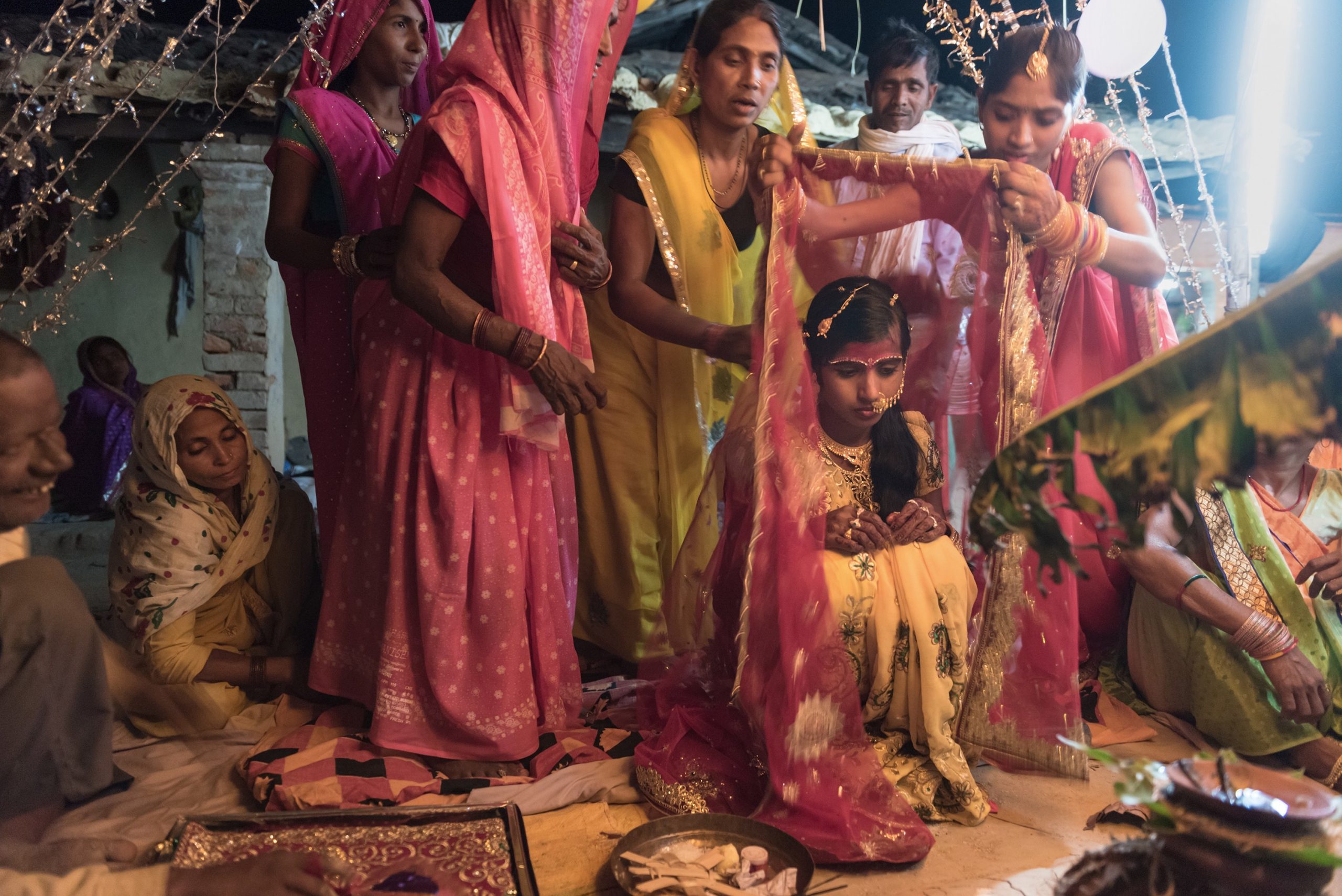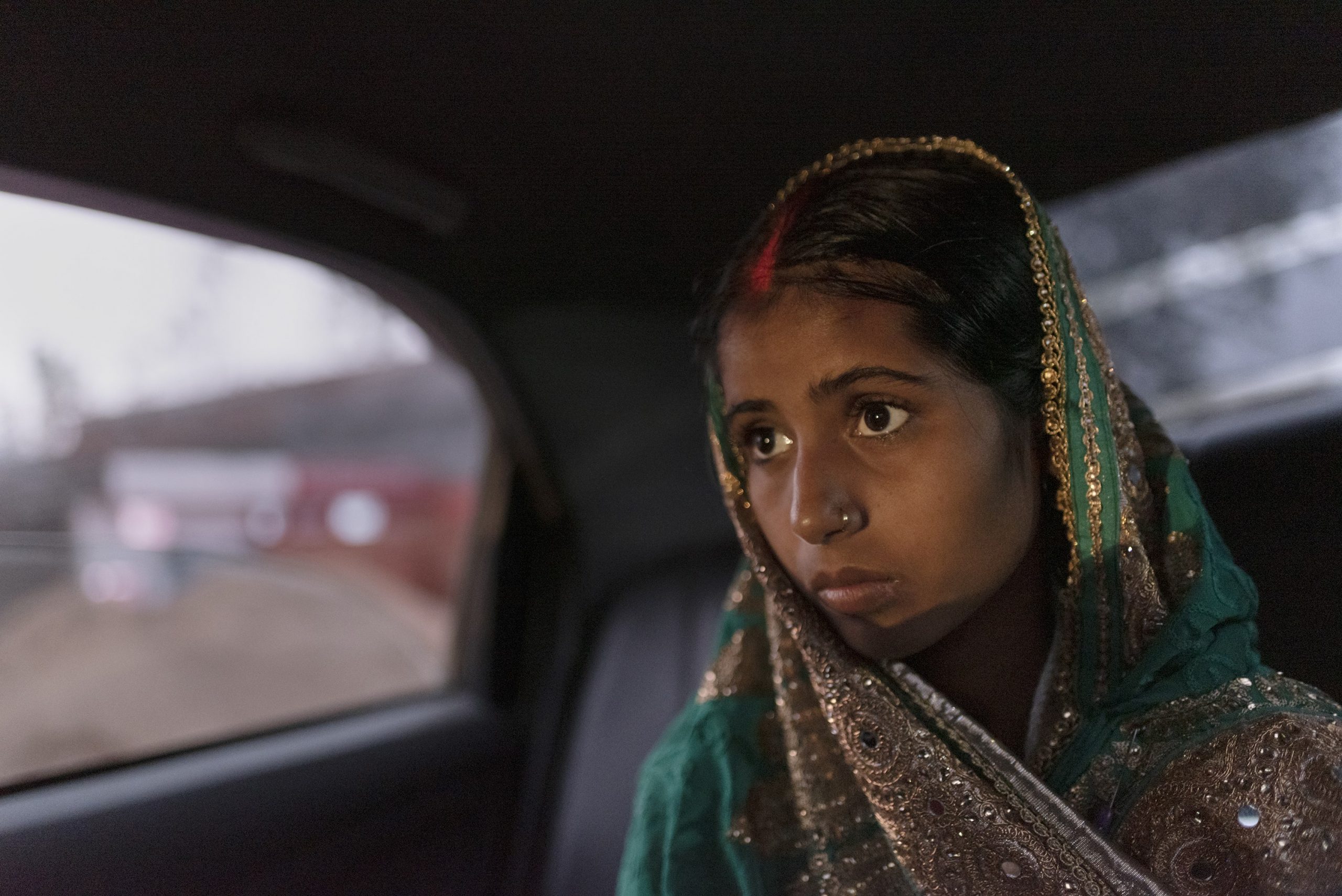by Saumya Khandelwal

Suman Nishad, twelve years old, from Kyotan Purva village became aware that she was getting married only when the ceremonial preparations began and haldi was applied on her according to custom.
Jaggi, ten years old, also from Kyotan Purva village, underwent the wedding rituals but understood that she had been married only after she was made to apply sindoor to her forehead daily while still living in her natal home.
Usha, fifteen years old, from Sahaadat Nagar came to know she was getting married only when the tilak ritual was performed, about five days before the actual ceremony.
Such is the case with most child brides – far too young to grasp the complex meanings of marriage, they can only understand it through these traditional symbols.

This story is set in Shravasti district of Uttar Pradesh. Bordering Nepal, the district has some of the worst statistics of child marriage in India.[1]
I knew much about child marriage in the context of Shravasti’s villages. I had analyzed the facts.[2] I had listed some of the uncomfortable questions to which I sought answers through my photographs:
Why does this practice persist?
Who are the worst victims?
Why do mothers who themselves have been child brides and have suffered the consequences push their daughters into the same vicious cycle?
What kind of relationship do the child couple come to share?
Is ‘love’ possible in such a marriage?
Do these girls ever imagine how their lives might turn out in the long run?
Do they even have the right to dream?

My search led to my meeting many young girls and listening to their stories. Photographing them, individually and collectively, in their own spaces affected me deeply.
I gravitated towards documenting one particular girl: Arti. Over the years I forged a friendship with her. Whenever I visited, she held my hand and showed me around. She was always in charge. At fourteen, she was fully capable of taking care of a household – cooking meals, washing clothes and utensils – as well as tending to the cattle.
I arrived at Arti’s home a day before her marriage in April 2017. On the morning of the ceremony she moved around the house, expertly attending to the guests, delegating work to her relatives. But her eyes were filled with apprehension. When I asked her how she felt about getting married, she confided, ‘What is there to feel? It happens with everyone.’

That day Arti was married to Rajkumar. At twenty-one, he worked tutoring students. He was interested in higher education and becoming a graduate; Arti, on the other hand, was not expected to foster any such aspirations for herself. The wedding ceremonies concluded with feuds between their respective families because the groom’s people were not happy with the dowry they were offered.
In these communities a girl does not start living with her husband and his family right after marriage. That typically happens after the gauna ceremony some time later; the bride then moves to her husband’s house and the marriage is consummated. But even while she remains in her natal home after the marriage ceremony, a girl’s life changes. She begins to be conditioned to her new status and its demands. Rajkumar had gifted Arti a phone so that the couple could talk regularly. He asked her not to step out of the house, and she complied.
After several months I came to the village to attend Arti’s gauna. For some reason I was expecting to see an adult bride, not my friend as she was – a vulnerable girl of fifteen. The sight of Arti really unsettled me, and the magnitude of what she would have to submit to hit me hard. I was not emotionally prepared to witness the sacrifice of her childhood.
Arti, however, was better prepared. After the gauna she went to her husband’s house in a car; as the only woman in her entourage, I accompanied her while her male family members and relatives followed in a tractor. Apparently confident and in control, as I had always observed her to be, she gave the driver directions. But her eyes revealed the fear she was living.
We reached her marital home. I stayed there overnight, her anchor in this unfamiliar space, as if she was mine to protect. The next morning she rose at 3 a.m. and waited for her mother-in-law to wake and tell her what to do. She bathed, and then prepared the first meal for her new family in her new house.


My next few interactions with Arti were a mixed experience. Sometimes it seemed she was struggling to adjust to her situation as a wife; at other times she expressed a fondness for her husband; and at yet other times I intuited the unspoken words overlaid by her silences. She had soon become pregnant, but it did not end well – she had a miscarriage, though as time passed she seemed to be starting to recover. But she contacted me less and less.
Then the coronavirus pandemic overwhelmed India.[3] In the ensuing chaos my communication with Arti was disrupted. After many failed attempts I finally managed to reach her father-in-law, only to hear from him that my friend, aged seventeen, had died. She took her own life, he said.
Arti’s own family contested the in-laws’ claim that she died by suicide, but no one acted on it because her elder sister had been married into the same family, and Arti’s parents were worried that their allegations would become a threat to her wellbeing.
There is no way to know if the claim is true, but the coercive, punitive reality of child marriage assaults me – a city person, with the right and freedom to dream, to make choices in work and in love – whenever I remember Arti. Denied their childhood, denied their will and desires, denied support and self-expression, so many girls like her succumb to the unforgiving repercussions of premature marriage, premature parenthood. And while many learn to cope, not everyone survives the hardships, trauma and tragedy embedded within this regressive and abusive system.[4]
Arti’s story is so much more than that of a village girl in Shravasti. It is the story of my friend, whom I cherished, and have lost.
Notes
- UNICEF estimates that India has over 226 million child brides, with 99.8 million married off before they turned fifteen. Over 50% of Indian child brides live in the states of Uttar Pradesh, Bihar, West Bengal, Maharashtra and Madhya Pradesh. As per the National Family Health Survey (NFHS-5: 2019-2021), the highest rates of child marriage in Uttar Pradesh are in districts along the Indo-Nepal border: Shravasti (51.2%); Bahraich (37.5%); Balrampur (35%) and Siddharthnagar (33.9%); second to Shravasti is Lalitpur (42.5%) in the Bundelkhand region. This survey also documents an overall drop in child marriage between 2015 and 2021. See Shivani Gupta, ‘Twelve-year-old Chimki was married off last year. She is one of the 226 million child brides in India’, Gaon Connection, 24 March 2022; https://www.gaonconnection.com/lead-stories/child-marriages-domestic-violence-women-empowerment-safety-education-health-uttar-pradesh-shravasti-covid-pandemic-50550. For a broad statistical account, see Padmavati Srinivasan et al, District-level Study on Child Marriage in India: What Do We Know about the Prevalence, Trends and Patterns? (New Delhi: International Centre for Research on Women / UNICEF, 2015); full text at https://www.icrw.org/wp-content/uploads/2016/10/District-level-study-on-Child-Marriage-in-India.pdf
- ‘According to the National Family Health Survey 2019-21 (NFHS-5), 23% of women between the age of 20 and 24 were married before 18 years of age. This figure has reduced significantly over the years from 47% in NFHS-3 (2005-06) to 27% in NFHS-4 (2015-16), and to 23% in the latest survey. In India, the practice of child marriage was first legally prohibited in 1929 through the Child Marriage Restraint Act, 1929. As per the 1929 Act, marriage of girls below the age of 14 years and boys below the age of 18 years was prohibited. This Act was amended in 1978 to increase the minimum age to 18 years for females, and 21 years for men.The Prohibition of Child Marriage Act, 2006 replaced the 1929 Act, with the same minimum age limits. The Prohibition of Child Marriage (Amendment) Bill, 2021 seeks to increase the minimum age of marriage for females to 21 years. The Bill was referred to the Standing Committee on Education, Women, Children, Youth, and Sports on December 21, 2021’; if passed, it ‘will override any other law, custom, or practice’. See ‘The Prohibition of Child Marriage (Amendment) Bill 2021’ at https://prsindia.org/billtrack/the-prohibition-of-child-marriage-amendment-bill-2021
- There were widespread legal and social fears that child marriages, especially in conditions of multi-dimensional poverty (affecting 75% of Shravasti’s population) would increase during the Covid-19 pandemic, given the lethal health crisis, school closures, debt, loss of jobs/income, and reverse worker migration from urban centres to home villages – all these factors contributing to the further spiral into abject deprivation suffered en masse by rural families. Additionally, programmes being conducted to educate panchayats about the illegality and consequences of child marriage were stopped due to lockdowns, social distancing mandates and the infection and quarantining of rural outreach workers. See Shivani Gupta, ‘Twelve-year-old Chimki was married off last year. She is one of the 226 million child brides in India’, Gaon Connection, op. cit.
- Girded by centuries of cultural logic combined with stark expediency, child marriage inflicts multiple modes of suffering on underprivileged girls, who have no choice but to accept their fate as a transaction between families. Their education is cut short as they drop out of school to marry. Coming from deprived homes, they are frequently malnourished and anaemic; their bodies are unprepared for pregnancy, leading to frequent miscarriages and maternal and infant deaths. In a country where women of all ages, classes and backgrounds are always vulnerable to sexual harassment, predation and violence, child marriage relieves parents of the heavy responsibility of protecting their daughters – who are often brutally abused by husbands and in-laws, and are too afraid to report it as the consequences might be even worse, or lead to honour killing. Under-educated or illiterate villagers do not understand what is defined as “legal” or “illegal”, and so continue the unrelenting practice, abiding by the “law” and codes of patriarchal custom. Political parties promising the rural electorate more gender equality and empowerment of women rarely campaign against child marriage.

Saumya Khandelwal is a contributing photojournalist with TIME, National Geographic, The New York Times and other major publications. She focuses on gender and environmental issues. She was a Getty Images Instagram Grantee 2017 for her work Child Brides of Shravasti.